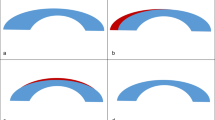Summary
Background: Long-term results on LASIK are not available to date. We therefore evaluated the predictability, stability and complication rate after LASIK in moderate – to-high myopia.
Patients and methods: We treated 70 eyes (41 patients) using the Automatic Corneal Shaper and the Keracor 116 excimer laser. Patients were followed for 1, 6, 12 and 24 months. Spectacle refraction, visual acuity, rate of retreatment, and patient satisfaction were evaluated.
Results: At 24 months the results were as follows: Myopia −5 to −9.9 D (n =18): 94 % within 1 D; regression between 1 and 12 (12 and 24) months > 1 D in 6 % (6 %); uncorrected acuity 20/40 or better in 83 %; no loss of 2 ore more lines of visual acuity; 89 % highly satisfied. Myopia −10 to −14.9 D (n = 12): 88 % within 1 D; regression between 1 and 12 (12 and 24) months > 1 D in 20 % (0 %) ; uncorrected acuity 20/40 or better in 72 %; 4 % lost 2 or more lines of visual acuity; 96 % highly satisfied. Myopia −15 to −29 D (n = 22): 33 % within 1 D; regression between 1 and 12 (12 and 24) months > 1 D in 41 % (18 %); uncorrected acuity 20/40 or better in 7 %; no loss of 2 or more lines of visual acuity; 67 % highly satisfied.
Conclusion: LASIK is an accurate, effective and stable procedure for correcting myopia of −5 to −10 D. Results are less precise in myopia up to −15 D, and some visual loss occurs in a number of patients. In myopia > −15 D, results are not satisfactory because of poor accuracy and low stability.
Zusammenfassung
Fragestellung: Bisher liegen keine Erfahrungen über die Langzeitergebnisse nach LASIK vor. Wir untersuchten daher die Präzision, die Stabilität und die Komplikationsrate nach LASIK zur Korrektur der mittleren und hohen Myopie.
Patienten und Methode: Eingeschlossen wurden 70 Augen (41 Patienten), die mit dem Automatic Corneal Shaper und dem Keracor 116 Excimer Laser operiert wurden und 1, 6, 12 und 24 Monate postoperativ nachuntersucht wurden. Wir untersuchten Refraktion, Visus, Reoperationsrate und Patientenzufriedenheit.
Ergebnisse: Nach 24 Monaten fanden sich folgende Ergebnisse: Myopie −5 bis −9,9 dpt (n = 18): 94 % ± 1 dpt; Regression zwischen 1 und 12 (12 und 24) Monaten > 1 dpt in 6 % (6 %); unkorrigierter Visus 0,5 oder besser in 83 %; kein Visusabfall um 2 oder mehr Stufen; 89 % sehr zufrieden. Myopie −10 bis −14,9 dpt (n = 25): 88 % ± 1 dpt; Regression zwischen 1 und 12 (12 und 24) Monaten > 1 dpt in 20 % (0 %); unkorrigierter Visus 0,5 oder besser in 72 %; Visusabfall um 2 Stufen in 4 %; 96 % sehr zufrieden. Myopie −15 bis −29 dpt (n = 27): 33 % ± 1 dpt; Regression zwischen 1 und 12 (12 und 24) Monaten > 1 dpt in 41 % (18 %); unkorrigierter Visus 0,5 oder besser in 7 %; kein Visusabfall um 2 oder mehr Stufen, 67 % sehr zufrieden.
Schlußfolgerung: Die LASIK stellt ein wirksames und stabiles Verfahren zur Korrektur der Myopie von −5 bis −10 dpt dar. Korrekturen bis −15 dpt zeigen eine geringere Genauigkeit und Langzeitstabilität sowie in einigen Fällen eine Verschlechterung der Sehschärfe. Korrekturen über −15 dpt sind aufgrund der geringen Genauigkeit und magelnden Stabilität als unbefriedigend anzusehen.
Similar content being viewed by others
Author information
Authors and Affiliations
Rights and permissions
About this article
Cite this article
Knorz, M., Jendritza, B., Liermann, A. et al. Laser in situ keratomileusis (LASIK) in myopia: 2-year results. Ophthalmologe 95, 494–498 (1998). https://doi.org/10.1007/s003470050304
Published:
Issue Date:
DOI: https://doi.org/10.1007/s003470050304




